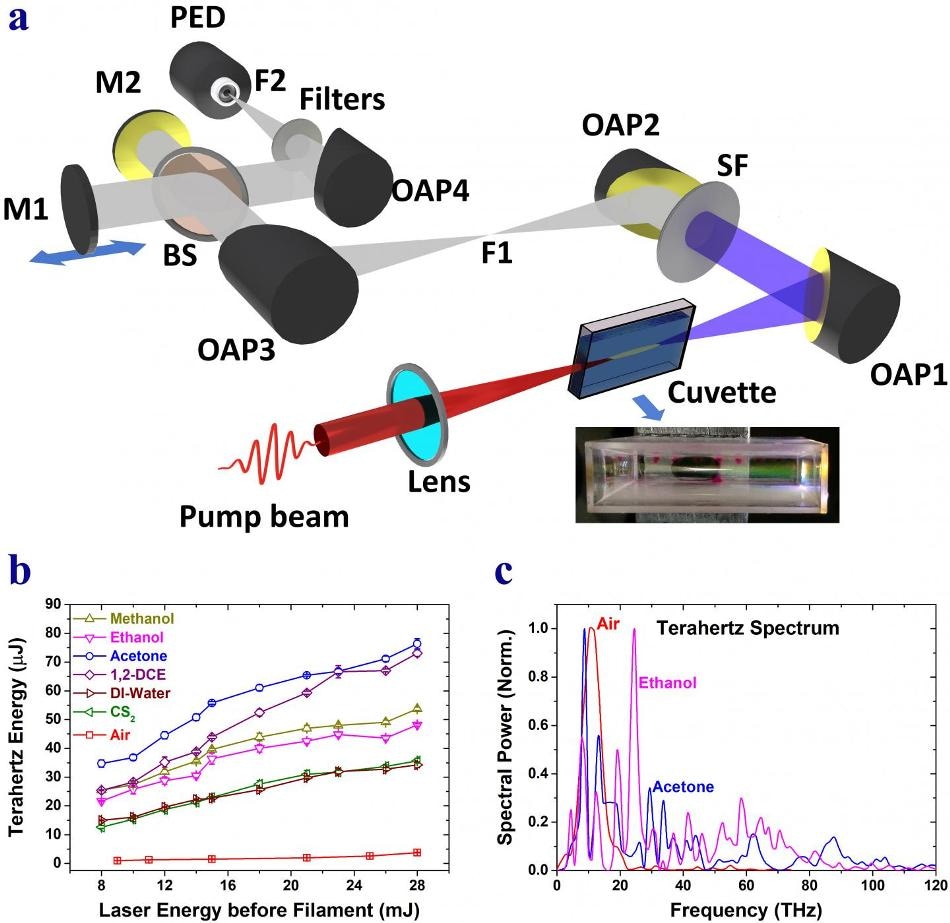Oct 31 2017
In a remarkable advancement, researchers from the Tata Institute of Fundamental Research (TIFR), Mumbai, have developed a high-power radiation source in the greatly needed teraHertz (THz) region of the electromagnetic spectrum.
The research was carried out in partnership with laboratories in Greece and France and has been published in the Nature Communications journal on October 30, 2017.
 (a) A high power laser pulse ionizes and creates plasma in a common laboratory liquid like acetone or dichloroethane or even water. The plasma can be seen as a long line along the length of the tube containing the liquid (see inset). This line is called a filament and it radiates, among others, copious teraHertz radiation. (b) Integrated teraHertz energy obtained from various liquids and air. (c) Power spectrum of teraHertz obtained from the filamentation of acetone, ethanol and air. CREDIT: Indranuj Dey, G. Ravindra Kumar.
(a) A high power laser pulse ionizes and creates plasma in a common laboratory liquid like acetone or dichloroethane or even water. The plasma can be seen as a long line along the length of the tube containing the liquid (see inset). This line is called a filament and it radiates, among others, copious teraHertz radiation. (b) Integrated teraHertz energy obtained from various liquids and air. (c) Power spectrum of teraHertz obtained from the filamentation of acetone, ethanol and air. CREDIT: Indranuj Dey, G. Ravindra Kumar.
The constant exploration for innovative and brighter radiation sources is a continuing search in the field of science and technology. Although there are various sources throughout the electromagnetic spectrum, the THz region—that falls between the infrared/optical region and the microwave region—has been problematic, and sources in this region have been available only from the last two decades. High-power THz radiation has normally been accessible from complex and large machines such as Free Electron Lasers. The energy outputs of compact sources that are dependent on special crystals and semiconductor antennas stimulated by visible/infrared femtosecond laser pulses are highly restricted and are usually in the nanojoule, one-billionth of a joule, level or even lower. They cannot be used for various applications. However, high-power femtosecond lasers have stimulated THz emissions that are nearly 1000 times larger (of the order of microjoules) when compared to emissions from plasma formed in air, under distinctive conditions.
For many decades, scientists researching in this field were of the notion that liquids do not emit notable THz radiation as they effectively reabsorb the generated radiation. However, the TIFR team was successful in this aspect. As part of the experiments, the team irradiated usual laboratory liquids—such as acetone, carbon disulphide, methanol, dichloroethane, and also water—with moderate-energy femtosecond laser pulses, thereby ionizing the liquids and forming long plasma channels known as filaments. Astonishingly, they could measure energies of 50 µJ, which was very high and nearly 1000 times greater than when compared the energies emitted by many of the prevalent sources, and 10-20 times greater than the emissions generated from air. Through cautious characterization and systematic analysis, the team demonstrated that the experimental conditions were very simple when compared to those required for air. The mechanism simplifying the large output, albeit the deleterious absorption, has been developed from models adopted by their theoretical partners from the Institute of Electronic Structure and Laser, Foundation for Research and Technology, Hellas, Greece; and Ecole Polytechnique, Paris. The fundamental principle of this model is that the femtosecond laser pulse initiates secondary emissions in the liquid, where these secondary emissions combine with the incident laser pulse to generate the observed THz radiation.
The TIFR team is very optimistic and confident that their liquid source will be the brightest of all compact, tabletop sources. They also believe that it will find various applications in THz nonlinear optics, material analysis, THz imaging, and explosives detection. This innovative source definitely enlarges the THz radiation stock. Can we consider the THz liquidity to be improved?